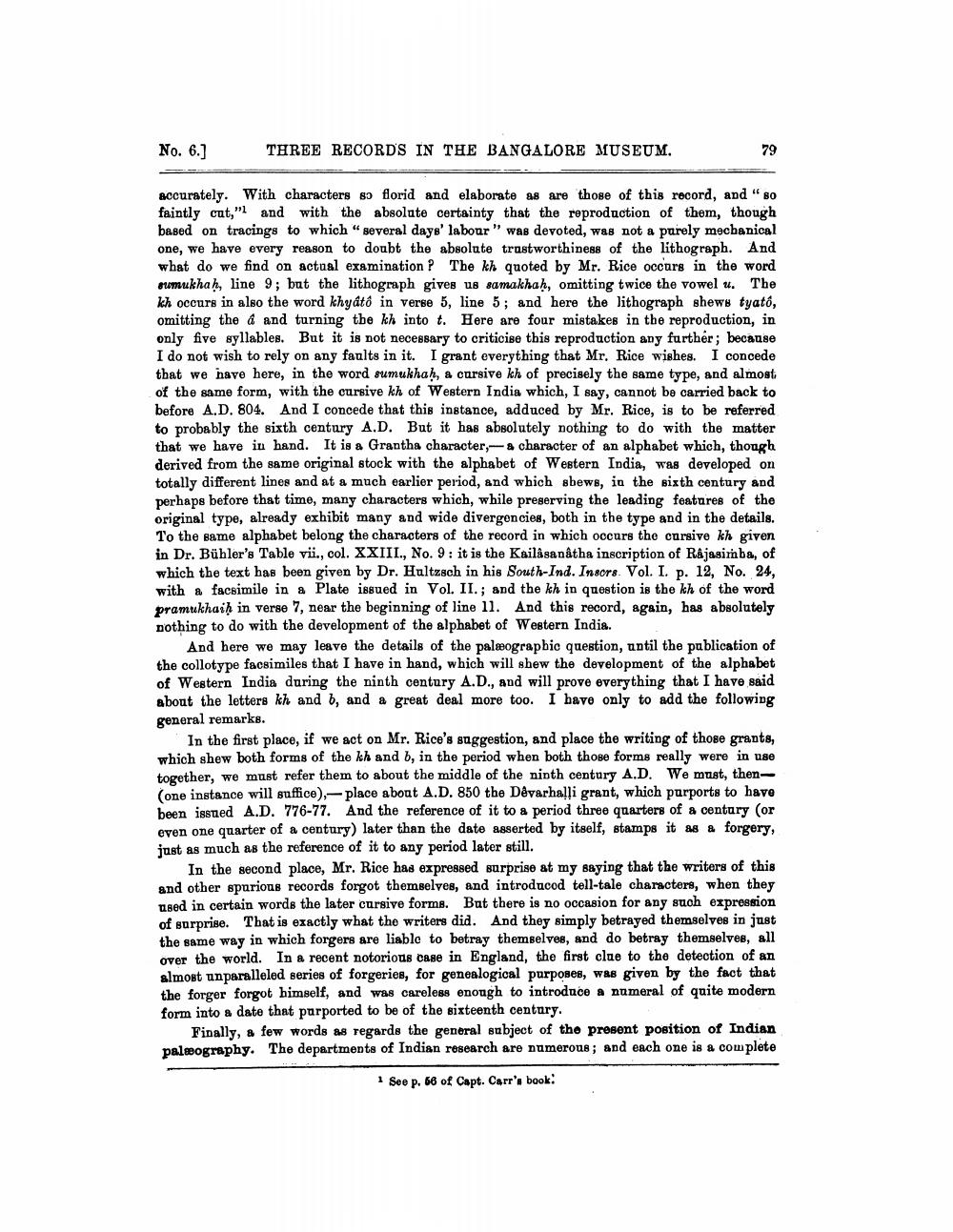________________
No. 6.]
THREE RECORDS IN THE BANGALORE MUSEUM.
79
accurately. With characters so florid and elaborate as are those of this record, and "so faintly cat," and with the absolute certainty that the reproduction of them, though based on tracings to which "several days' labour" was devoted, was not a purely mechanical one, we have every reason to doubt the absolute trustworthiness of the lithograph. And what do we find on actual examination ? The kh quoted by Mr. Rice occurs in the word sumukhah, line 9; but the lithograph gives us samakhah, omitting twice the vowel u. The kh occurs in also the word khyátó in verse 5, line 5; and here the lithograph shewe tyato, omitting the d and turning the kh into t. Here are four mistakes in the reproduction, in only five syllables. But it is not necessary to criticise this reproduction any further; because I do not wish to rely on any faults in it. I grant everything that Mr. Rice wishes. I concede that we have here, in the word sumukhah, a cursive kh of precisely the same type, and almost of the same form, with the cursive kh of Western India which, I say, cannot be carried back to before A.D. 804. And I concede that this instance, adduced by Mr. Rice, is to be referred to probably the sixth century A.D. But it has absolutely nothing to do with the matter that we have in hand. It is a Grantha character,-- a character of an alphabet which, though derived from the same original stock with the alphabet of Western India, was developed on totally different lines and at a much earlier period, and which sbews, in the sixth century and perhaps before that time, many characters which, while preserving the leading features of the original type, already exhibit many and wide divergencies, both in the type and in the details. To the same alphabet belong the characters of the record in which occurs the cursive kh given in Dr. Bühler's Table vii., col. XXIII., No. 9: it is the Kailasanatha inscription of Rajasirnba, of which the text has been given by Dr. Hultzsch in his South-Ind. Insors. Vol. I. p. 12, No. 24, with a facsimile in a Plate issued in Vol. II.; and the kh in question is the kh of the word pramukhaiḥ in verse 7, near the beginning of line 11. And this record, again, has absolutely nothing to do with the development of the alphabet of Western India.
And here we may leave the details of the palæograpbic question, until the publication of the collotype facsimiles that I have in hand, which will shew the development of the alphabet of Western India during the ninth century A.D., and will prove everything that I have said about the letters kh and b, and a great deal more too. I have only to add the following general remarks.
In the first place, if we act on Mr. Rice's suggestion, and place the writing of those grants, which shew both forms of the kh and b, in the period when both those forms really were in use together, we must refer them to about the middle of the ninth century A.D. We must, then(one instance will suffice),-- place about A.D. 850 the Devarhalli grant, which purports to have been issued A.D. 776-77. And the reference of it to a period three quarters of a century (or even one quarter of a century) later than the date asserted by itself, stamps it as a forgery, just as much as the reference of it to any period later still.
In the second place, Mr. Rice has expressed surprise at my saying that the writers of this and other spurious records forgot themselves, and introducod tell-tale characters, when they used in certain words the later cursive forms. But there is no occasion for any such expression of surprise. That is exactly what the writers did. And they simply betrayed themselves in just the same way in which forgers are liable to betray themselves, and do betray themselves, all over the world. In a recent notorious Case in England, the first clue to the detection of an almost unparalleled series of forgeries, for genealogical purposes, was given by the fact that the forger forgot himself, and was careless enough to introduce a numeral of quite modern form into a date that purported to be of the sixteenth century.
Finally, a few words as regards the general subject of the present position of Indian palmography. The departments of Indian research are numerous; and each one is a complete
See p. 68 of Capt. Carr's book!




